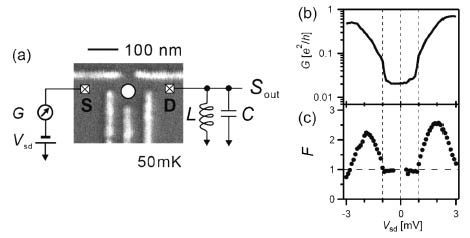in the Elastic and Inelastic Cotunneling Regimes
@
1Physical Science Laboratory, 2Tohoku University
Shot noise is a time-dependent current fluctuation reflecting
the discreteness of charge carriers. Measurements of shot noise in coherent
conductors such as a quantum dot (QD) are expected to reveal dynamical
mechanisms and underlying correlation in electron transport. Electron cotunneling
is a higher-order tunneling process observed in the Coulomb blockade regime.
Cotunneling is classified into elastic and inelastic processes; the former
involves only the QD ground state, while the latter accompanies dynamical
charge fluctuation between the ground and excited states. Shot noise measurements
have been reported only for the inelastic cotunneling regime in a carbon
nanotube QD [1]. For semiconductor QDs, on the other hand, shot noise measurements
in the cotunneling regime are made more challenging by the even lower cotunneling
current inherent to semiconductor QDs [2].
Here we study the shot noise in a semiconductor QD in
the cotunneling regime. We fabricate a small QD [Fig. 1(a)], in which the
level spacing ’E can be increased up to 1 meV. Owing to this large’E, we can obtain cotunneling current high enough as compared to the resolution of our noise measurement setup. Figure 1(b) shows the conductance G as a function of source drain bias Vsd. For a small bias range (|Vsd| < 1 mV), we find small but finite conductance due to elastic cotunneling. For a large bias range (|Vsd| > 1 mV), on the other hand, G is strongly enhanced due to the strong
inelastic cotunneling. Figure 1(c) shows the Fano factor F, which is determined
from the measured current noise Sout and current I [F = Sout / 2eI with e being the electron charge]. We observe the Poissonian Fano factor
F ~ 1 in the elastic cotunneling regime. On the other hand, we observe an
enhancement of the Fano factor up to F ~ 2.5 (super-Poissonian Fano factor) in the inelastic cotunneling regime.
This large Fano factor results from the fact that the inelastic cotunneling
is accompanied by an emission of excess electrons, which leads to electron
bunching and enhances the shot noise [3]. The observed difference in the
value of the Fano factor can be utilized as a new spectroscopic measurement,
by which we can quantitatively distinguish the microscopic origins of charge
transport.
[1] E. Onac et al., Phys. Rev. Lett. 96 (2006) 026803.
[2] S. Gustavsson et al., Phys. Rev. B 78 (2008) 155309.
[3] Y. Okazaki, S. Sasaki, and K. Muraki, Phys. Rev. B 87 (2013) 041302(R).
@
 |
||
|